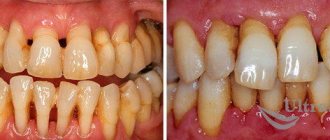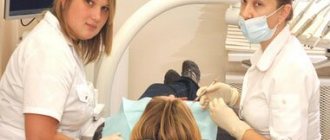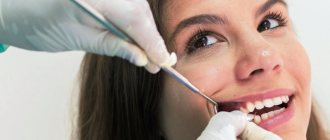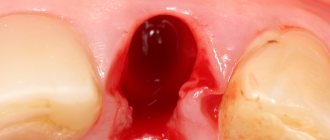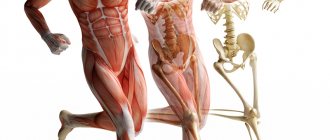Date of publication: 06/22/2012
Jaw bone atrophy is a progressive loss of bone tissue with a visible decrease in the height and width of the alveolar process of the jaw. Most often, bone atrophy develops after tooth loss, and this can also be facilitated by long-term inflammatory diseases of the oral cavity, anatomical features, age-related changes, congenital anomalies, various injuries of the maxillofacial area, tumor processes in the jaws, and general diseases.
Also, the jaw, deprived of load, decreases in size and hence the premature appearance of wrinkles and changes in the shape of the face. If one tooth is removed, the other teeth take on the load. As you know, nature abhors a vacuum. Neighboring teeth begin to shift towards the resulting defect. This leads to changes throughout the entire dentition. As a result, chewing function is impaired, resulting in bone tissue atrophy.
Two-stage implantation with delayed loading ROOTT - RUB 32,000.
One-stage implantation with immediate loading in 3 days - 44,000 rubles.
The price for complete restoration of teeth on 1 jaw in 3 days is 265,000 rubles.
Periodontitis and periodontal disease - what are these diseases?
Periodontitis and periodontal disease are often confused with each other, considering them one disease with different names. Both in a neglected state actually lead to the same consequences - bone tissue atrophy and further tooth loss, have a pathological effect on the entire body, but at the same time they differ from each other in the nature of their occurrence, causes of development and symptoms. To understand the difference between periodontal disease and periodontitis, let's look at their definitions.
- Periodontitis is an infectious inflammation of the complex of tissues (periodontal) surrounding the tooth. It occurs as a consequence of gingivitis - superficial inflammation of the gums, which without treatment becomes chronic and affects the deeper layers of tissue - not only the gums, but also the cementum of the root, periodontium, and the upper part of the jawbone.
The prevalence of periodontitis is indicated by the figures: after 35 years, signs of this disease occur in 86% of cases, while 20% of dental patients have a severe form of this disease[1].
- Periodontal disease is a periodontal disease, which is based on tissue degeneration, disruption of their nutrition and, as a result, destruction. Periodontal disease is much less common; as an independent disease it is diagnosed in only 3-5% of patients. However, many experts attribute it to complications of gum inflammation, i.e. when they are literally “healed” to such an extent that their nutrition is disrupted, there is no longer inflammation, there is simply dystrophy.
%akc54%
Stages of implant installation for bone deficiency
Implantation in case of bone deficiency is necessarily preceded by bone grafting. It can be carried out as a separate stage or simultaneously with the installation of titanium roots. It is strictly forbidden to install a crown or prosthesis immediately after the procedure. It is important to ensure reliable fusion of the graft and artificial root with the jaw bone to avoid displacement. Implantation includes the following stages:
Preparatory
The most important stage to which we pay maximum attention. We examine the patient’s oral cavity, identify diseases of the teeth and gums, and prescribe treatment. We examine the maxillofacial apparatus, determine the size of the bone, on the basis of which a decision is made on the need for osteoplasty. Also at the preparation stage, a diagnosis of the patient’s health condition is carried out to identify possible contraindications. At the same time, surgery planning, computer modeling, selection of models and placement of implants in the jaw are carried out.
Bone tissue augmentation
If atrophy of the jaw bone is detected at the preparatory stage, osteoplasty is performed. Rehabilitation after the procedure takes 4-5 months. During this time, the transplant completely takes root. If the bone size allows, bone augmentation is carried out simultaneously with implantation, which significantly reduces treatment time.
Implantation
Performed using a patchwork method. The implantologist dissects and peels off the gum mucosa, uses special tools to form a hole into which he screws the implant and performs manipulations to increase the size of the bone (if one-step plastic surgery is indicated). Then he closes the rod with a plug screw and applies sutures. Osseointegration of the artificial root with the jaw tissue takes 4-5 months. During this time, a temporary removable denture is made to hide the aesthetic defect.
Prosthetics
After the structure has healed, the gum is dissected again, the plug is removed, and a gum former is placed to create a beautiful gum contour. After 2 weeks, the former is replaced by an abutment, and impressions are taken. The final stage is fixation of the crown or fixed prosthesis.
How diseases arise - features and differences
The reasons are the main thing that distinguishes these diseases. In most cases, inflammation of the gums and periodontitis are caused by prolonged accumulation of bacterial plaque and stone on the enamel and under the gums. It is poor and irregular oral hygiene that initially provokes slight inflammation of the gums, and its penetration deep into the tissue is a matter of time. Pathogens and mechanical trauma to the mucous membrane lead to irreversible processes in the periodontium[2].
Insufficient and unsatisfactory oral hygiene is the main, but not the only cause of the disease. A share of 10% falls on general diseases of the body, which serve as an impetus for the development of pathology, namely diabetes, osteoporosis, leukemia and others.
What is the difference between periodontal disease and periodontitis in dentistry? In addition to the terms and manifestations themselves, the difference is also in the reasons, which are not fully understood. On the one hand, the disease is non-inflammatory in nature and is caused by metabolic disorders. It is known that periodontal disease begins not from the gums, but from the bone parts of the jaw, where sclerosis of the feeding vessels occurs - a reduction in the diameter of the vascular tubes. For this reason, the supply of oxygen and necessary substances to all tissues is disrupted, which leads to the gradual death of cells. Most often, this is how the first (mild) stage of this disease develops. However, the next two are interrelated with periodontitis and are its consequence.
Also, long-term and conservative treatment of gum inflammation leads to periodontal disease, in which the infectious component is removed, but nothing is done to restore tissue (in the moderate and severe stages).
Key differences in disease manifestations
With periodontitis, there are three stages or degrees of the disease - mild, moderate and severe - without treatment, the disease increases over time. And the symptoms, accordingly, depend on the duration of inflammation. In general, the disease is characterized by acute redness of the mucous membrane, the formation of a large amount of plaque and hard stone on the teeth and under the gums. Due to the lack of comprehensive treatment, inflammation from the gums spreads to the bone, which gradually literally “melts” and shrinks in volume. In this case, mobility of the elements necessarily occurs with their subsequent loss from the hole. The photo below makes it clear what we are talking about.
With periodontal disease, the gums do not become inflamed, but decrease in size due to metabolic disturbances and become “whitish” (this sign can be seen in the photo). The patient may not even be aware that the bone tissue is shrinking. The disease can proceed completely unnoticed and will gradually lead to tooth loss. The condition of bone tissue can be determined by X-ray examination - there are three stages of development of periodontal disease depending on bone loss - mild, moderate, severe.
Prices
The cost of the operation depends on the chosen technique. The most expensive will be implantation with preliminary osteoplasty: the process is labor-intensive and expensive artificial material is used.
A classic operation and a protocol with an immediate load will cost approximately the same if several elements need to be restored. When a complete or almost entire row of teeth is missing, one-stage implantation is cheaper due to fewer implants and a reduction in the number of operations.
Free online consultation with a dentist
| Service | Price |
| Directed regeneration in the area of 1 tooth (excluding material cost) | from 10,000 rub. |
| Sinus lifting in the area of one tooth (excluding the cost of material) | from 10,000 rub. |
| Installation of a classic implant ROOTT FORM (Switzerland, Trate AG) | from 27,000 rub. from 32,000 rub. promotion |
| Guided bone tissue regeneration (for 1 zone excluding material cost) | from 35,000 rub. |
| Open sinus lift, bone grafting (for 1 zone, excluding material cost) | from 35,000 rub. |
| Osteoplasty with splitting of the alveolar ridge (for 1 zone excluding the cost of material) | from 35,000 rub. |
| Installation of a one-stage implant (Switzerland, Trate AG) with an adaptation crown | from 44,000 rub. |
| Installation of a classic ROOTT implant with an adaptation crown (Switzerland, Trate AG) | from 44,000 rub. |
| Installation of a one-stage multi-unit implant with screw fixation (Switzerland, Trate AG) with an adaptation crown | from 50,000 rub. |
| Installation of a classic Nobel implant (Sweden, Nobel Biocare) | from 60,000 rub. |
| Installation of a classic Nobel implant (Sweden, Nobel Biocare) with an adaptation crown | from 85,000 rub. |
| One-stage complex implantation for completely edentulous one jaw, including an adaptive prosthesis (combination of 6-12 COMPRESSIVE, BASAL implants of the ROOTT system (Switzerland, Trate AG) on a metal frame with cement fixation. | from 265,000 rub. |
| One-stage complex implantation for completely edentulous one jaw, including an adaptive prosthesis (combination of 6-12 COMPRESSIVE, BASAL implants of the ROOTT system (Switzerland, Trate AG) on a titanium frame with cement fixation | from 230,000 rub. from 295,000 rub. promotion |
| One-stage complex implantation for completely edentulous one jaw, including an adaptive prosthesis on a titanium frame supported by 6-12 implants of the ROOTT system (Switzerland, Trate AG) multi-unit with screw fixation | from 295,000 rub. from 325,000 rub. promotion |
| One-stage complex implantation with complete edentia of both jaws, including an adaptive prosthesis (combination of 12-24 COMPRESSIVE, BASAL implants of the ROOTT system (Switzerland, Trate AG) on a metal frame with cement fixation | from 480,000 rub. |
| One-stage complex implantation with complete edentia of both jaws, including an adaptive prosthesis (combination of 12-24 COMPRESSIVE, BASAL implants of the ROOTT system (Switzerland, Trate AG) on a titanium frame with cement fixation | from 495,000 rub. |
| One-stage complex implantation for completely edentulous 1 jaw, including a ceramic-composite prosthesis, put on on days 3-4, a combination of 6-12 screw-fixed implants, ROOTT system (Switzerland, Trate AG). No re-prosthetics required | from 580,000 rub. |
| One-stage complex implantation with complete edentia of both jaws, including an adaptive prosthesis on a titanium frame supported by 12-24 implants of the ROOTT system (Switzerland, Trate AG) multi-unit with screw fixation | from 590,000 rub. |
Consultation and diagnostics are free!
All prices Promotions
Comparison of characteristic symptoms of two pathologies
How these diseases differ from each other can be judged from the table.
At the initial stage
| Periodontitis | Periodontal disease |
|
|
In the middle stage
| Periodontitis | Periodontal disease |
|
|
At a severe (advanced) stage
With periodontal disease at this stage, bone tissue atrophy reaches 2/3 of the height of the roots, the teeth cannot be held in place - mobility occurs, the roots are exposed by 6 mm or more, pain increases while eating, even to the point of refusing to eat and oral hygiene in order to do not cause pain, dental units look unattractive - visually large crowns and narrow elongated roots violate the aesthetics of a smile.
The following symptoms occur with periodontitis:
- gums can be either inflamed and swollen, or pale due to lack of nutrition,
- severe pain with any impact, even with tongue movements and conversation,
- there is burning and itching,
- suppuration intensifies, pus is contained in large quantities under the gums,
- plaque and stone surround the tooth on all sides, fill periodontal pockets,
- periodontal pockets reach 5 mm or more,
- Pathological mobility of teeth occurs (grades II and III), when the teeth deviate not only to the sides, but also up and down by a distance of more than 1 mm, and can rotate around their axis. Often they are held in the holes only by accumulated stone,
- the root of the tooth is exposed more than half of its height,
- bone tissue declines catastrophically, its level has dropped to half the height of the root,
- teeth have nothing to hold on to - they begin to fall out,
- Traumatic occlusion occurs (closing of the jaws), malocclusion due to the loss of individual units.
Important! At the last stage, periodontitis can take on an acute form, when all the symptoms sharply intensify. Then patients experience fever, increased body temperature, severe pain and suppuration. All this affects both a person’s physical well-being and his psychological state - many people experience stress and depression due to problems in the oral cavity very acutely.
In this case, periodontitis can (though quite rarely) develop locally in one area or be generalized - widespread throughout the entire oral cavity. Periodontal disease is always a generalized form, when the disease affects both dentitions, and not individual units.
In addition to destruction in the oral cavity, the disease harms the entire body, affecting the functioning of internal organs. It has consequences for many systems and organs, no less dangerous than itself.
Complications that occur if the disease is not treated
In addition to destruction in the oral cavity, chronic inflammation harms the entire body, affecting the functioning of internal organs - the gastrointestinal tract, heart, liver and kidneys, and has a destructive effect on blood vessels. The culprit is pathogenic bacteria, which weaken the immune system and cause diseases no less dangerous than periodontitis. Thus, microorganisms of the oral cavity, together with food and saliva, penetrate into the stomach and intestines, causing digestive disorders - gas formation, indigestion and pain, followed by gastritis, duodenitis and other diseases [3]. There are cause-and-effect relationships between stomach diseases and disturbances in metabolism and in obtaining all the necessary microelements and vitamins.
An even more dangerous complication of chronic inflammation is kidney disease, such as pyelonephritis and renal failure. They develop in a non-obvious way: the bloodstream brings pathogenic microorganisms to the kidneys, where the immune system destroys “strangers”, as elsewhere, but the proteins of pathogens at the molecular level are very similar to kidney cells - the immune defense also works on the kidney’s own cells, simultaneously destroying them.
Periodontitis affects both blood vessels and the heart. All the same pathogenic bacteria cause endocarditis, heart attacks, heart attacks, affect the brain, 3 times increasing the likelihood of Alzheimer's disease. Scientists have proven the connection between the disease and a 6-fold increase in the risk of stroke and diabetes. 8 times more likely to develop pregnancy complications (miscarriage, premature birth, low birth weight) if the child’s mother has periodontitis.
Advanced periodontal disease provokes the development of periodontitis, which significantly worsens the clinical picture and requires complex and long-term treatment.
Causes of jaw bone destruction
The disease develops due to a combination of several factors. Under other identical conditions, patients are at risk:
- with poor oral hygiene;
- with periodontitis;
- after dental surgery, including tooth extraction;
- taking large doses of bisphosphonates for a long time;
- during chemotherapy and corticosteroid therapy;
- undergoing treatment with anticancer drugs;
- with diabetes;
- with poorly fitting, chafing dentures.
Infections of any etiology significantly increase the likelihood of getting sick. Untreated, carious teeth open the way for pathogens not only into the oral cavity. In advanced cases, when purulent discharge begins, the infection enters the general bloodstream and spreads throughout the body. On the other hand, sinusitis, otitis, and sore throats are a huge number of pathogens that provoke serious dental diseases. Complications in both cases can lead to osteomyelitis, and this can lead to necrosis of the jaw.
What is the diagnosis of diseases based on?
Accurate determination of the disease and its stage will allow timely and appropriate treatment to begin. But, unfortunately, many clinics limit themselves to x-rays and visual assessment of the oral cavity, which does not always allow a detailed understanding of the problem. But, in addition to the symptoms, for successful treatment it is necessary to determine the cause of the disease and evaluate what was the impetus for its development. To do this, a differential diagnosis is carried out, consisting of several successive stages:
- the doctor examines the oral cavity, noting signs of disease. Using instruments, measurements are made of the depth of periodontal pockets, the amount of deposits,
- an anamnesis is collected about the time of the disease, its manifestations, the patient’s feelings, as well as the quality of oral hygiene,
- to assess the condition of the bone and get details of the problem, a computed tomography (CT) scan is performed,
- Bacterial plaque and stone from periodontal pockets are taken for examination to determine the composition of the microflora and its resistance or sensitivity to drugs,
- The diagnosis is completed with blood tests (general and sugar); additional blood tests for hormones may be needed.
Diagnosis of periodontal disease at the initial stage of the disease is difficult due to the non-obviousness of the symptoms and is also not limited to one visual examination. However, even at the first stage, radiography can detect bone atrophy. The diagnosis is made on the basis of an orthopantomogram and visual and instrumental examinations. For greater accuracy, microscopic examination of the gums is used to assess the degree of disruption of microcirculation in them.
How to protect bone from atrophy: treatment of periodontitis and periodontal disease
Over decades of dental research and practice, many methods have been found to treat gums, dental ligaments and jaw bones with periodontitis and periodontal disease. In recent years, developments in microbiology and advances in the field of periodontics and biomaterials have brought the latest effective developments and drugs. Some time ago, periodontitis was considered an irreversible disease, and even at the initial stage it was necessary to take into account the fact that with all methods of treatment and prevention, a temporary result was achieved, albeit for a long time - for several years. Today, the first two stages of the disease can be successfully treated in adults and children, as well as restoration of bone and gum levels thanks to advanced methods and drugs.
To achieve results in restoring oral health, an integrated approach is essential. To treat this disease, you cannot choose just one effective and proven method, since you need to influence the problem from all sides: it is important to eliminate the cause, stop the inflammatory process and subsequently restore the periodontium and ligamentous apparatus.
However, at the third chronic stage of the disease, considerable treatment efforts are, as a rule, insufficient to completely eliminate the disease, and the only solution remains to remove the remaining affected teeth as the source of inflammation and the focus of the disease.
Periodontal disease has a different clinical picture, and the treatment of this disease is based on other methods. Let's look at them in more detail later in the article.
Alternative Methods
Removable dentures Recommended if there are absolute contraindications to implantation or if there is a limited budget
ReSmile Modern technology for rapid restoration of teeth with complete edentia with the installation of a permanent prosthesis
Mini-implants Removable prosthetics with mini-implants MDI
Article Expert
Nesterenko Alexey Pavlovich Surgeon-implantologist, doctor of the highest category
Work experience: more than 11 years
What methods of treating periodontitis exist and is it possible to restore bone tissue?
In each specific case, an individual comprehensive approach is chosen for treatment, depending on the manifestations of the disease and the time of its course. It is important to understand that treatment of the disease is long, complex, multi-level and quite expensive. It also provides for the simultaneous solution of several problems:
- stopping infectious inflammation,
- prevention of further spread of the pathological process,
- preservation of the functions of the dental system,
- prevention of complications,
- prevention of effects on the entire body and health in general.
Professional oral hygiene
The very first and mandatory stage is cleaning the teeth and periodontal pockets from deposits. The elimination of a huge number of pathogens contained in plaque and stone is carried out using ultrasound, devices such as Vector and Varios. Antiseptic treatment of the enamel and gum surfaces is also required to create a smooth and favorable environment for further treatment. Cleaning allows you to eliminate deposits on the surface and at a depth of up to 3 mm under the gums.
Closed and open gum curettage
These methods involve surgical intervention when the depth of deposits is more than 3 mm, and professional cleaning alone is not enough. Using a special dental instrument - a curette - periodontal pockets are cleaned and granulations are removed at a depth of 4 mm. If the deposits are even deeper, then open curettage is used. In this case, a gum flap is removed to allow access to and cleanse the affected tissue. After cleansing, the gums are returned to their place and stitches are applied.
Drug therapy
Along with cleansing the enamel and roots, a course of treatment with antibiotics is prescribed to strengthen the gums and improve tissue nutrition. During the year they return to courses up to 5-7 times.
Plasmolifting, or PRF membranes
This method involves the use of one's own protective and regenerative mechanisms. Point injections into the gums of the patient's blood plasma with his platelets promote rapid tissue healing and relief of inflammation. Blood cells rich in a special protein, fibrin, “seal” damaged and bleeding vessels and restore gums, thereby reducing inflammation.
Mandatory and regular independent oral hygiene
Without it, all therapeutic measures will be ineffective and simply useless. It is important to maintain the achieved results at home and independently prevent deposits in the oral cavity. Brushing with a toothpaste, using floss and brushes after each meal, and using antibacterial rinses are mandatory measures for patients.
Splinting mobile teeth
At the stage of mobility of units, bone atrophy reaches such a level that they can no longer be held in the sockets on their own. Further loosening of them will only speed up the moment of falling out - they are fixed artificially with special splints. Mobile units are combined into a group with relatively healthy ones using fiberglass or metal splints or a splinting prosthesis (clasp).
Important! Splinting without accompanying drug therapy and the above treatments will cause even more harm over time. If you simply splint a row and leave the periodontal areas without treatment and strengthening, then quite quickly, under load, the units of the dentition will loosen even more and fall out as a whole group along with the splint.
Application of biomaterials with active growth factors
Combining all of the above methods with advanced developments in the field of nanotechnology and biomaterials has made it possible to create revolutionary therapeutic periodontal complexes designed for a year. They can not only stop the development of periodontitis, but also reverse it. In the first two stages of the disease, up to 80% restoration of damaged areas is possible within a year thanks to the use of innovative materials and drugs. The Straumann company, one of the leaders in the field of implantology, has developed a new generation of biomaterials enriched with growth factors (primarily Emdogain® for gum restoration, artificial bone materials BoneCeramic®, Bio-Oss®), which allow you to return and re-grow lost during the disease process, root cement, periodontal ligaments, raise the level of bone and gum.
All of these methods are highly effective in the initial and middle stages of the disease. At the third advanced stage of inflammation, this approach will also bear fruit, but the solution will be temporary. At some point, the patient will still be faced with the question of prosthetics: despite the treatment, advanced periodontitis cannot be completely cured. Read below about how the issue is resolved at this stage of the disease.
What is the treatment for periodontal disease?
The treatment of periodontal disease differs significantly from periodontitis in methods and is aimed not at eliminating bacterial foci of inflammation, as in the first case, but at restoring nutrition to tissues, both bone and soft. For this purpose, all means are used to help restore blood circulation. However, often the moderate and severe stages of periodontal disease are combined with periodontitis and also bear all the signs of this disease. Then there is a need for a comprehensive solution.
Physiotherapeutic methods
They are presented in a fairly wide range: it is possible to use electrophoresis, phonophoresis, conventional and vibration vacuum massage, magnetic therapy, diadynamic currents and laser therapy. Each of the methods is aimed at reviving the activity of tissues subject to atrophy. Thus, electro- and phonophoresis together with the substance heparin reduces tissue hypoxia and improves blood circulation and transportation of necessary substances. Vacuum massage is carried out with a special device, creating areas of rarefaction and pressure in the tissues in order to stimulate metabolic processes. Laser therapy is also aimed at this. Treatment with such methods is a course course and requires repetition several times throughout the year.
But, unfortunately, not every clinic has its own physiotherapy department. Usually dentistry at medical universities can offer a solution to this issue.
Drug treatment
For the treatment of periodontal disease, medications have also been developed to stimulate metabolic processes in tissues. Antioxidant vitamins work for this: E, A, the entire group B, as well as P. Medicines also include anabolic steroids and blood circulation stimulants.
Partial grinding of tooth surfaces
In patients with periodontal disease, excess calcium is found in the enamel and its natural wear does not occur. This leads to the bite becoming traumatic, causing the front elements to move apart like a fan, causing pain and wedge-shaped defects. To reduce this phenomenon or prevent its development, enamel is polished in a dental office and normal tooth contacts are restored.
Splinting on mobile teeth
At the stage when tooth mobility has already occurred due to periodontal disease, they are fixed in a fixed position using fiberglass splints or clasp dentures, just as with periodontitis.
Bone atrophy, periodontitis and dental implantation
Is dental implantation possible for periodontitis and periodontal disease? It is important to understand that in the later stages these diseases cannot be completely cured. Of course, you can constantly undergo a course of treatment, do curettage, plasma lifting, and use other methods, but if you leave the diseased teeth or their roots in place, the inflammation will continue to progress.
The porous structure of the tooth serves as the environment for the development of the disease. If there is no focus of inflammation, then the pathological process caused by the accumulation of microorganisms also stops.
Many patients hope for prosthetics, but it is important to understand that in this case, classic prostheses will not help, but will only worsen the problem. Traditional bridges or dentures do not solve the problem of atrophy. Removable ones do not transfer the load to the bone, and bridges must be attached to supporting units, which require turning for this purpose (which already damages them). In the future, they too may fail, since atrophy under the “empty space” covered by the crown continues: all units move in a row into the resulting empty space, break the bridge and become loose themselves.
At the same time, restoration of oral health is possible with the help of dental implants. In general, this is the most effective method to get rid of periodontitis and periodontal disease forever. And here complex implantation often becomes the option of choice.
Modern implantation methods involve the restoration of lost units even with minimal bone volume without the need to build it up. These are all immediate loading techniques, such as All-on-4, All-on-6, basal and zygomatic technology. With the development of such a scenario, both partial implantation (restoration of a segment) and complete implantation of the entire dentition are possible.
How to understand that tissue atrophy is occurring?
- the patient’s face “sinks,” the skin in the jaw area sags, nasolabial wrinkles become more pronounced;
- the gum contour recedes;
- displacement of dental units occurs;
- neighboring crowns become more mobile.
In dental practice, there are four main types of bone atrophy: minor, moderate, pronounced, and severe atrophy of bone tissue. So, with minor atrophy, implantologists can still introduce a titanium root into the jaw without restoring the bone, but with a rough form, they cannot do without restoring the volume.
Which implantation technique to choose in a specific situation?
Implantation at the initial and middle stages
If periodontitis is at an initial or middle stage, then the lost segments can be restored with implants, but under one most important condition - the remaining diseased teeth will be treated and the risk of implant rejection will be minimal. Periodontal complexes like Smile Recovery allow you to combine the treatment of periodontitis, periodontal disease and subsequent implantation. Only then can we talk about a successful result. However, there are unscrupulous dentists who offer the installation of implants near the affected elements, which is absolutely forbidden to do! In this case, there is a high risk of peri-implantitis and rejection.
If the patient has completed a course of periodontal restoration, then he may be suitable for classical two-stage implantation with delayed prosthetics - when a fixed prosthesis is placed 3-6 months after surgery. Or the express method, i.e. implantation with immediate prosthetics - here the patient will receive a full-fledged prosthesis either on the day of the operation or within 3-7 days after it. There is no need to wait here for months. The current concepts are called All-on-4, All-on-6 - they are used for mild or moderate bone atrophy, respectively.
Implantation at a late stage of pathologies
At the third stage of periodontitis or periodontal disease, it is difficult to talk about the effectiveness of conservative treatment. After examination on a computed tomography scanner, which clearly shows bone atrophy, it is recommended to remove diseased teeth and perform complex implantation with immediate loading of the prosthesis. This can even be a one-step technique, when implants are placed immediately after removal - and there is no need to wait for the hole to heal. For patients with pronounced bone atrophy and gum inflammation, solutions such as basal implantation (for the upper and lower jaw) on implants with antibacterial coating, and the zygomatic technique (only for the upper jaw) are suitable.
What are the possible consequences of atrophy?
Losing a tooth is not only fraught with cosmetic consequences, i.e. aesthetic defects. Functional impairments also occur. After all, healthy teeth have to take on excess load while chewing food. This means they break down much faster. In addition, all the teeth in the row shift and become mobile - after all, some of them lack lateral support. In general, the bite and facial expressions are disturbed, and wrinkles appear. The lips sink inside the mouth, problems arise with the pronunciation of various sounds, because the tongue loses support in the form of teeth, a decrease in the lower part of the face is observed, and flabbiness of the masticatory and facial muscles develops2. In addition, the digestive organs suffer, since a person most often switches to softer foods, since it is too difficult to chew excessively hard foods.
Options for solving the problem of bone loss
The main solution to the problem of bone loss is, of course, to prevent it, i.e. prevention. This means that after tooth extraction, you need to consider the option of surgical restoration or protecting the bone tissue from shrinkage. The first option will be discussed below, but the second involves the installation of protective barrier membranes. They are installed in the socket of the extracted tooth, and if necessary, a little artificial bone is added inside. In this way, it is possible to replenish the missing bone volume, making it possible to implant a tooth without using an extension procedure (but this is provided that it was not possible to install the implant immediately, i.e. at the time of tooth root removal).
So, when a patient is faced with a problem such as atrophy, bone tissue restoration can be performed using the following methods:
- sinus lift: performed exclusively on the upper jaw and allows you to lift or shift the maxillary sinus in order to make room for new bone. This operation is only applicable to change the height of the jaw bone,
- bone grafting with artificial materials: in this case, the jaw bone tissue is split and the freed space is filled with synthetic bone,
- bone block grafting method: for this procedure, the patient’s own bone material is used, usually extracted from the lower jaw (from the wisdom teeth area). The gum is cut, a bone block of the required size is cut out - it is transplanted to a new place and fixed with screws. Bone granules are placed around, and a membrane is attached to protect the tissue from being washed out.
Bone augmentation is a procedure that, although not complicated for an experienced surgeon, is very specific (and for the patient as well). When transplanting a bone block, at least 2 incisions are made, which means the patient will have to monitor the condition of several wounds at once. Plus additional material expenses: building up a large area of bone tissue is especially expensive.
“The cost of bone grafting is from 19-20 thousand rubles. And this does not take into account the implantation itself. In addition, the operation significantly lengthens the treatment process - at least 3-4 months must pass before the grafted bone can be used to install implants. Therefore, in our practice we use implantation methods that eliminate bone grafting. For the patient, this saves both time and money.”
Zhilenko Evgeniy Aleksandrovich, Implant surgeon, periodontist, orthopedist Work experience over 17 years make an appointment



